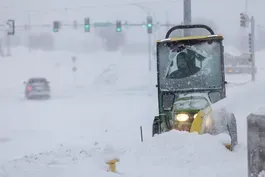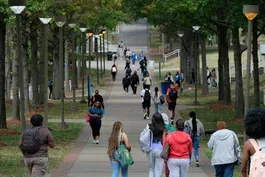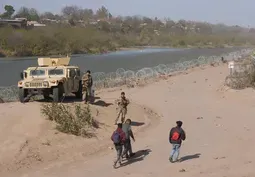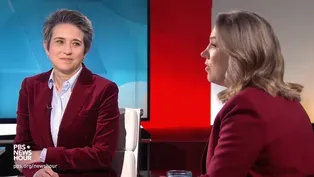
'Eve' dispels human evolution myths and female body's role
Clip: 1/15/2024 | 6m 49sVideo has Closed Captions
New book 'Eve' dispels myths about human evolution and details female body's role
Where do we come from and how did we evolve into the beings and bodies we are today? The new book "Eve: How the Female Body Drove 200 Million Years of Human Evolution" argues for a better understanding of our origins with critical implications for our present. Jeffrey Brown spoke with author Cat Bohannon for our arts and culture series, CANVAS.
Problems with Closed Captions? Closed Captioning Feedback
Problems with Closed Captions? Closed Captioning Feedback
Major corporate funding for the PBS News Hour is provided by BDO, BNSF, Consumer Cellular, American Cruise Lines, and Raymond James. Funding for the PBS NewsHour Weekend is provided by...

'Eve' dispels human evolution myths and female body's role
Clip: 1/15/2024 | 6m 49sVideo has Closed Captions
Where do we come from and how did we evolve into the beings and bodies we are today? The new book "Eve: How the Female Body Drove 200 Million Years of Human Evolution" argues for a better understanding of our origins with critical implications for our present. Jeffrey Brown spoke with author Cat Bohannon for our arts and culture series, CANVAS.
Problems with Closed Captions? Closed Captioning Feedback
How to Watch PBS News Hour
PBS News Hour is available to stream on pbs.org and the free PBS App, available on iPhone, Apple TV, Android TV, Android smartphones, Amazon Fire TV, Amazon Fire Tablet, Roku, Samsung Smart TV, and Vizio.
Providing Support for PBS.org
Learn Moreabout PBS online sponsorshipbut what if we saw it as the evolution of woman?
A new book argues for a better# understanding of our beginnings,# with critical implications for our present.
Jeffrey Brown explains.
And it's for# our arts and culture s JEFFREY BROWN: Where do we come from and how did# we evolve into the beings and bodies we are today?## It's a story that continues to fascinate at the# American Museum of Natural History in New York.
Human origins.
CAT BOHANNON, Au JEFFREY BROWN: Whe child and now with a call for a new# CA T BOHANNON: We have a lot of stories about# the evolution of mammals.
We especially have## a lot of stories about the evolution# of humanity and its possible past.
But, weirdly, in so many of these stories,## the female is at best a side character.# You know what I in many different disciplines, whether# it's anthropology or in biology,## we're putting that female back in the picture.# And that actually changes how we tell JEFFREY BROWN: Bohannon tells the story in "Eve:## How the Female Body Drove 200# Million Years of Human In fact, with personal whimsy as well as# scientific data, she writes of many Eves,## starting with a creature she nicknames# Morgie, perhaps the first ever breast-feeder.
CAT BOHANNON: It's delightful that the reason# someone like me might have breasts is because## there is this little weaselly creature 200# million years ago living under the lite feet of dinosaurs and she starts lactating.# And that's why, right?
So that's just fun.
JEFFREY BROWN: And she gives# us other Eves who bring tools,## language and a whole lot more into the# tale of the human spec CAT BOHANNON: It's really rewarding to# remember how deeply ancient these things are,## that the body is in many ways a unit of# time, right, with different things that## arrive at different points in time, that# this human brain is incredibly recent,## right, and that my digestive# system is incredibly ancient.
These Eves are meant to give us a way# into where these features of our bodies## might have come from and how that story# still shapes how we live in them today.
JEFFREY BROWN: For Bohannon, whose Ph.D. research## was in cognitive psychology and# lite an example of how hominins and early humans# learned to problem-solve, is in childbirth.
You say we're one of the# worst.
We are terrible at it.
CAT BOHANNON: Oh, yes.
Yes.
JEFFRE CAT BOHANNON: Absolutely.
And we do# that by having behavioral work which is that deep human story.
It's kind# of what we're always doi finding behavioral work-arounds# for the limitations of our body.
JEFFREY BROWN: She took us a long way back.
CAT BOHANNON: How you doing,# Luce?
How's it han JEFFREY BROWN: To Lucy, the version# of her on disp are actually casts.
The actual Lucy of# the species Australopithecus afarensis## was discovered in present day Ethiopia in 1967.
Bohannon's focus, Lucy's pelvis.
CAT BOHANNON: The pelvic opening has narrowed,## which is part of what enables us to# be up here, And some really, really good scientists# have determined problem as we do.
She had the# obstetric dilemma.
She had big## babies and had a hard time getting# out of, well, a small pelvic opening.
JEFFREY BROWN: Right, which a# lot of women will relate to.
CAT BOHANNON: Yes, I did that twice.
I'm good.
Yes.
So, but the thing is that means that story,# th million years ago.
And the current theory is# that actually Lucy probably had a midwife.
JEFFREY BROWN: Lucy had a midwife?
CAT BOHANNON: Lu chimpy.
But she had a midwife, because# she had difficult births that needed help,## and in that moment of vulnerability,# to get them out.
Yes.
Yes, yes, yes.
And that's a big part of our success story,# which we don't normally talk about, but yes.
JEFFREY BROWN: Bohannon loves that famous# first scene of Stanley Kubrick's "2001:## A Space Odyssey."
But she wants# us to focus less on conflict,## more on gynecology, and how a focus# on evolution of the female body can## change how we think of the development# of other traits, such as language.
CAT BOHANNON: We assume there are these# grand moments where language arrives,## usually about hunting,# shouting directions across... JEFFREY BROWN: Yes, of course.
Isn't# that the sta CAT BOHANNON: It's a common story.
JEFFREY BROWN: OK. CAT BOHANNON: It's a common story.
all of these mixed-sex members of a group.
And# when you look at the evolution of language in## terms of its developmental path, it becomes# a childhood story very quickly.
And, frankly,## most of the time that's happening with the# mother, in part because breast-feeding.
This is when -- you're connected, literally# connected, many hours a day to a face which## is communicating with you at those# critical moments of brain development.
JEFFREY BROWN: Bohannon's book, which# synthesizes the work of hundreds of# scientists, many of them women,# raises numerous such examples.
But it also raises critical implications# for women's health today and addresses## the so-called male norm that has# traditionally guided medical science.
CAT BOHANNON: That, for a very long time# in biology and in biomedical research,## we're mostly studying male subjects.# That's how we control for estrus,## the messiness of that hormonal cycle, was just# taking them literally out of the equation.
And we're only just starting to finally# rectify that.
This is kind of a paradigm shift,## kind of a sea change.
And we don't# entirely know what biological sex## differences are going to deeply matter,# yet we will know the more we study it.
JEFFREY BROWN: We still don't know?
CAT BOHANNON: Absolutely not, world are doing that work right now,# which is why this book can even JE FFREY BROWN: She points to the growing# awareness of different responses by men and## women to opioids, for example, and the need for# better guidelines to dist CAT BOHANNON: Because we live in the bodies# we do that have this deep evolutionary time,## our health is affected by how# well we understand that history.
Our medicine is shaped by how well we're able to# incorporate better knowledge about literally what## these things are.
And what we are is made of where# we came from, because that's how evolution works.
JEFFREY BROWN: Deep time down to the present# day in a still-developing story of evolution.
For the "PBS NewsHour," I'm Jeffrey Brown at the# American Museum of Natural History in New York.
Arctic blast grips much of U.S. bringing brutal temperatures
Video has Closed Captions
Clip: 1/15/2024 | 2m 20s | Arctic blast grips much of U.S. bringing brutal temperatures and dangerous wind chills (2m 20s)
How a $100M donation is a game-changer for HBCUs
Video has Closed Captions
Clip: 1/15/2024 | 6m 20s | How a $100M donation is a game-changer for HBCUs (6m 20s)
Iowans face freezing temperatures in 1st contest of 2024
Video has Closed Captions
Clip: 1/15/2024 | 10m 33s | Iowans face freezing temperatures to caucus in 1st contest of 2024 campaign (10m 33s)
Iranian-backed groups raise threat of wider Mideast conflict
Video has Closed Captions
Clip: 1/15/2024 | 5m 19s | Iranian-backed groups raise threat of drawing U.S. into a wider Middle East conflict (5m 19s)
Rep. Cuellar on Texas border dispute after migrant deaths
Video has Closed Captions
Clip: 1/15/2024 | 7m 5s | Rep. Cuellar on border dispute between Texas, federal officials after migrant deaths (7m 5s)
Tamara Keith and Amy Walter on Iowa caucus expectations
Video has Closed Captions
Clip: 1/15/2024 | 8m 33s | Tamara Keith and Amy Walter on Iowa and the start of the Republican nominating process (8m 33s)
Providing Support for PBS.org
Learn Moreabout PBS online sponsorshipSupport for PBS provided by:
Major corporate funding for the PBS News Hour is provided by BDO, BNSF, Consumer Cellular, American Cruise Lines, and Raymond James. Funding for the PBS NewsHour Weekend is provided by...

















